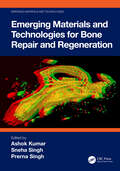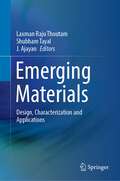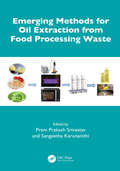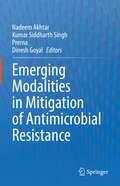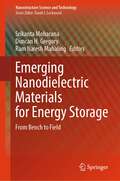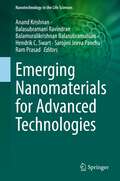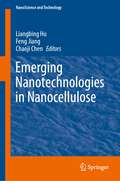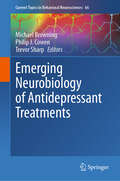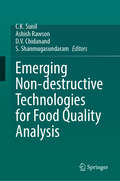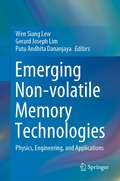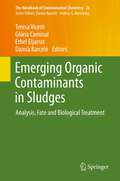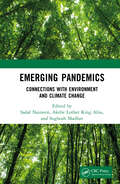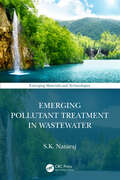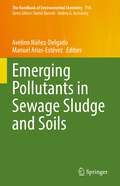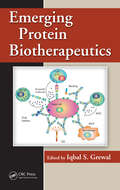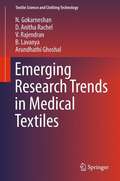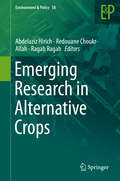- Table View
- List View
Emerging Materials and Technologies for Bone Repair and Regeneration (Emerging Materials and Technologies)
by Prerna Singh Ashok Kumar Sneha SinghThis book covers advancements in the field of bone repair and regeneration. It introduces bone development, repair, and regeneration and details different biomaterials and technologies involved in the fabrication and characterization of bone-related scaffolds and implants. The book explores nanotechnological intervention and folklore phytomedicines and their prospects in regenerating bone including major bone related disease conditions, infection, and their tackling via tissue engineering strategies.FEATURES: Covers polymer materials and technologies for bone repair and regeneration based on tissue engineering Defines the interdisciplinary mechanism of bone tissue repair ranging from the fields of material science, nanotechnology, and phytomedicine includes basic sciences, scaffolds, and bone infection Examines fabrication and characterization methods for the bone repair materials Reviews fundamentals of interlinked mechanisms of bone development, repair, and regeneration. This book is aimed at graduate students and researchers in biomedical and tissue engineering and biomaterial sciences.
Emerging Materials for Biofuel Developments (Emerging Materials and Technologies)
by López-Maldonado, Eduardo Alberto Selvakumar Periyasamy R. BalachandranThis book explores and summarizes the recent innovations in emerging materials for technological developments of biofuels. It explains synthesis paths under the controlled strategy, characterizations, functional modifications, and applications of various potential emerging materials.Emerging Materials for Biofuel Developments covers the application of emerging materials in different competent biological feedstocks and their conversion routes. It highlights the significance of emerging materials in overcoming challenges and enhancing biofuel technologies’ efficiency, sustainability, circular economy, feasibility, and prospects. This book: includes synthesis and characterization of emerging materials for biofuels reviews processing technologies of biomaterials for biofuels discusses applications in energy generation, transportation, and industrial operations explores the commercialization of biofuels examines future opportunities in biofuel technology developments. This book is aimed at graduate students and researchers in chemical, bioprocess, and environmental engineering.
Emerging Materials: Design, Characterization and Applications
by J. Ajayan Shubham Tayal Laxman Raju ThoutamThis book serves as a quick guide on the latest material systems including their synthesis, fabrication and characterization techniques. It discusses recent developments in different material systems and discusses their novel applications in various branches of science and engineering. The book briefs latest computational tools and techniques that are used to discover new material systems. The book also briefs applications of new emerging materials in various fields including, healthcare, sensors, opto-electronics, high power devices and nano-electronics. This book helps to create a synergy between computational and experimental research methods to better understand a particular material system.
Emerging Methods for Oil Extraction from Food Processing Waste
by Prem Prakash Srivastav Sangeetha KarunanithiEmerging Methods for Oil Extraction from Food Processing Waste is a comprehensive and cutting-edge exploration of sustainable oil extraction practices, catering to professionals and researchers in food science. The book, spanning 13 insightful chapters, intricately reviews the extraction of oil from food processing by-products, including pomace and surplus raw materials. It specifically focuses on emerging non-thermal technologies, offering valuable insights into improving oil extraction rates. The discussions encompass factors influencing extraction rates and suggest processing conditions based on various extraction methods and raw materials. In addition to providing a nuanced understanding of conventional and novel extraction techniques, the text delves into the diverse applications of the extracted oil, ranging from food preservation to fortification and fat replacement. Notably, it covers advanced processing techniques for enhancing oil stability, bioavailability, and bioactivity through emulsion and encapsulation methods. Addressing crucial commercial aspects, the text explores economic feasibility, safety considerations, and consumer acceptability, providing a holistic perspective for successful industrial adaptation. Authored by global specialists, each chapter offers in-depth scientific reports and critical analyses, making this volume an indispensable resource for continuous research and advancement in the dynamic field of food processing.
Emerging Modalities in Mitigation of Antimicrobial Resistance
by Nadeem Akhtar Dinesh Goyal Kumar Siddharth Singh PrernaAntimicrobial resistance (AMR) is one of the deadliest threats to global public health. This book focuses on dynamics in the landscape of AMR while informing about the latest technologies and strategies to mitigate it. The menace of AMR in different niches, routes of penetration across various domains, socio-economic impact, and the need for a 'One Health' approach in mitigating AMR has been emphasized. Factors involved in AMR, underlying mechanisms, and pharmacometrics in developing antimicrobials are highlighted. Emphasis is given to emerging technologies that are sustainable, scalable, and applicable to the global community, such as big data analytics, bioactive agents, phage therapy, and nanotechnology. The book also explores current and alternative treatment strategies to combat AMR, emphasizing the use of nanoparticles to target pathogens and as a viable alternative to antibiotics.
Emerging Nanodielectric Materials for Energy Storage: From Bench to Field (Nanostructure Science and Technology)
by Srikanta Moharana Duncan H. Gregory Ram Naresh MahalingThis contributed volume presents multiple techniques for the synthesis of nanodielectric materials and their composites and examines their applications in the field of energy storage. It overviews various methods for designing these materials and analyses their properties such as mechanical strength, flexibility, dielectric as well as electrical performances for end-user applications such as thin-film flexible capacitors, advanced energy storage capacitors, and supercapacitors. The book gives a special focus on examining the dielectric properties of polymer-based nanomaterials, core-shell structured nanomaterials, and graphene-based polymeric composites among others, and explains the importance of their use in the aforementioned energy storage applications. It provides a great platform for understanding and expanding technological solutions needed for global energy challenges and it is of great benefit to industry professionals, academic researchers, material scientists, engineers, graduate students, physicists, and chemists working in the area of nanodielectrics.
Emerging Nanomaterials for Advanced Technologies (Nanotechnology in the Life Sciences)
by Ram Prasad Hendrik C. Swart Anand Krishnan Balasubramani Ravindran Balamuralikrishnan Balasubramanian Sarojini Jeeva PanchuOver the past decade the world has seen the rise of the fascinating and diverse field currently recognized as nanotechnology. This book covers a broad spectrum of topics within nanotechnology, including synthesis techniques, various innovative characterization techniques, growth mechanisms of nanomaterials, the physics and chemistry of nanomaterials, diverse functionalization methods, and the various applications of nanomaterials in biology, therapeutics, energy, food science, and environmental science. It also discusses applications of nanostructured materials, integrative applications such as nano- and micro-electronic sensor devices, as well as agricultural and environmental remediation applications. The book also includes a discussion of advances in functionalized nanomaterials (0D, 1D, 2D and 3D) and covers the early stages of the development of functionalized nanostructures, considering the future for 2D nanomaterials and 3D objects. Additionally, it includes a chapter on nanomaterial research development that highlights work on the life-cycle analysis of nanostructured materials and toxicity aspects.This book proves useful for researchers and professionals working in the field of nanomaterials and green technology, as well as in the field of nanotechnology. It should be useful to students and specialized researchers in a number of disciplines ranging from biology, chemistry, and materials science to engineering and manufacturing in both academia and industry.
Emerging Nanomaterials: Opportunities and Challenges in Forestry Sectors
by Azamal Husen Hamid R. Taghiyari Jeffrey J. MorrellBio-based materials, including those containing wood, will become increasingly important as we move to a bio-based economy. Among their many attributes, it is vitally important that these materials are renewable, sustainable with proper management and environmentally benign. Wood remains one of our most important bio-based materials. While it is an amazing material, wood still has negative attributes and drawbacks that can affect performance, including dimensional instability when wetted, vulnerability to fire and high temperatures, and susceptibility to biodeterioration. A variety of treatments have been developed to overcome these weaknesses. Among the most exciting of these treatments are nanomaterials. These materials have some exceptionally attractive properties for improving timber performance and have been the subject of intensive research over the past decade. There is a tremendous need for a single comprehensive source of information on this rapidly emerging subject with tremendous potential to enhance the performance of a variety of bio-based materials. This book contains 10 chapters, each compiled by different author(s) who are considered the top researcher(s) in their respective fields. The chapters begin with some basic background on nanomaterials and their synthesis, then explore different areas for potential applications and conclude with a review of the emerging questions about nanomaterial safety. The book is designed to provide the latest information and know-how on application and utilization of different nanomaterials to improve the properties of wood and wood-based composite panels. The contents cover some main topics in the industry including improving physical and mechanical properties, increasing resistance to biodegradation (including fungi and insects), developing wood-plastic composites (WPC), applying nanomaterials in paper and board industry, and emergence of transparent wood and radiation shielding. It also covers the use of nanomaterials to improve the performance of paints and finishes used for forest products. The book provides a single location for those interested in the field to begin.
Emerging Nanotechnologies in Nanocellulose (NanoScience and Technology)
by Liangbing Hu Feng Jiang Chaoji ChenThis book provides expert coverage of the current state of the art in the application of nanotechnologies to cellulose research. It offers a comprehensive collection of topics including nanocellulose isolation, assembly into hierarchical structures, and advanced emerging applications. During the past decades, research in nanocellulose has advanced quickly, driven by the urgent needs for sustainability and the availability of advanced nanotechniques. Although cellulose has been investigated and used for thousands of years, the recent advances in nanotechnology have transformed our view of this natural substance. Cellulose, when present in the highly crystalline nanoscale form, can demonstrate interesting mechanical, optical, and fluidic properties that can be manipulated in designing materials with novel applications.This book contains 12 chapters. Chapter 1 focuses primarily on the fundamentals of nanocellulose, including general aspects on its structure, isolation, and characterization. Chapters 2-4 summarize the recent progress on assembly of nanocellulose into the macroscopic scale using state-of-the-art techniques. Chapters 5-13 cover the most advanced applications of nanocellulose in emerging areas, including superstrong materials, light management, electronics, energy storage, printed battery, water treatment, nanogenerator, and biomedicine. The book will appeal to upper undergraduate and graduate students through practicing researchers as a comprehensive reference on the subject of nanocellulose and its use in various fields.
Emerging Neurobiology of Antidepressant Treatments (Current Topics in Behavioral Neurosciences #66)
by Michael Browning Trevor Sharp Philip J. CowenThis volume is unique in bringing the exciting range of antidepressant treatment developments together with a focus on their neurobiological mechanisms and how these interact with the known pathophysiology of depression. Current evidence for treatment efficacy is reviewed together with a discussion of where in the management pathway of this common condition, these new approaches might take their place.
Emerging Non-destructive Technologies for Food Quality Analysis
by S. Shanmugasundaram Ashish Rawson C. K. Sunil D. V. ChidanandNon-destructive quality analysis refers to a method of food testing that is designed explicitly to eliminate the potential of damage to the food quality. There are various techniques by which this approach may be applied, all of which are being used recently for quality analysis, which provides important information on food characteristics such as texture, structure, and mechanical, physical and chemical properties. Conventional methods of quality analysis are time consuming, expensive and invasive in nature, particularly for long-duration analysis. Non-destructive methods have thus become highly appealing for their potential to reduce cost and waste and to shorten processing times. These approaches not only preserve the integrity of the product but also expedite the analysis process. The most common non-destructive methods used include machine vision, Spectroscopy, E-nose/tongue, Ultrasonics, and hyperspectral imaging, among others. While these methods have been in practice for some time, the technological advancements of the last decade have improved the precision and reliability of these tools, making them more popular. An overview of the dominant non-destructive methods, including the more novel technologies such as biosensors and terahertz application, have not until now been comprehensively covered in the form of a research volume. Emerging Non-destructive Technologies for Food Quality Analysis brings together detailed information on all these most current advances in technology and elucidates their application in food processing. Covering theory, principle, recent advances and practical applications in food analysis, this book will be an invaluable reference for students, researchers, food trainers and industry personnel.
Emerging Non-volatile Memory Technologies: Physics, Engineering, and Applications
by Wen Siang Lew Gerard Joseph Lim Putu Andhita DananjayaThis book offers a balanced and comprehensive guide to the core principles, fundamental properties, experimental approaches, and state-of-the-art applications of two major groups of emerging non-volatile memory technologies, i.e. spintronics-based devices as well as resistive switching devices, also known as Resistive Random Access Memory (RRAM). The first section presents different types of spintronic-based devices, i.e. magnetic tunnel junction (MTJ), domain wall, and skyrmion memory devices. This section describes how their developments have led to various promising applications, such as microwave oscillators, detectors, magnetic logic, and neuromorphic engineered systems. In the second half of the book, the underlying device physics supported by different experimental observations and modelling of RRAM devices are presented with memory array level implementation. An insight into RRAM desired properties as synaptic element in neuromorphic computing platforms from material and algorithms viewpoint is also discussed with specific example in automatic sound classification framework.
Emerging Organic Contaminants and Human Health
by Damia BarceloThis volume provides an overview of the occurrence and fate of emerging contaminants, discusses advanced chemical analysis methods, toxicological and ecotoxicological effects as well as human exposure. One focus is on pharmaceuticals, in particular antibiotics, and the problems associated with their increased use in hospitals. Other covered emerging contaminants occurring e.g. in food, water, air or soil include brominated flame retardants, polar pesticides, phthalates, phosphate esters, perfluorinated compounds, personal care products, musk fragrances, disinfection byproducts, illicit drugs, and nanomaterials. The chapters written by experts are a valuable source of information for a broad audience, such as analytical chemists, environmental chemists and engineers, toxicologists, ecotoxicologists and epidemiologists working already in this field as well as newcomers.
Emerging Organic Contaminants in Sludges
by Damià Barceló Ethel Eljarrat Glòria Caminal Teresa VicentThere are a growing number of new chemicals in the environment that represent an ascertained or potential risk. Many of them can be found in sewage sludge and are the subject of this volume. Experts in the field highlight their occurrence and fate, risks of biosolid use, advanced chemical analysis methods, and degradation techniques with a special focus on biodegradation using fungi. In the final chapter conclusions and trends are offered as a point of departure for future studies. The double-disciplinary approach combining environmental analysis and engineering makes the book a valuable and comprehensive source of information for a broad audience, such as environmental chemists and engineers, biotechnologists, ecotoxicologists and professionals responsible for waste and water management.
Emerging Organic Contaminants in Soil: Properties, Translocation, and Remediation (Emergent Environmental Pollution)
by Ming Zhang Mahtab AhmadEmerging organic contaminants (EOCs) are either newly identified or newly detected contaminants that are toxic or potentially hazardous to the ecosystem. The EOCs include, but are not limited to, pharmaceuticals and personal care products (PPCPs), antibiotics, perfluoroalkyl sulfonate (PFAS), flame retardants, endocrine disruptors, etc., presenting new challenges for scientists, policymakers, and the public. Soil is one of the most important sinks of EOCs arising from industrial emissions, incidental discharge, wastewater irrigation, or atmospheric deposition. The presence of EOCs in soil may threaten the soil ecosystem’s health and subsequently transfer to humans via food and water consumption. This book provides comprehensive knowledge on the behavior and translocation of EOCs in soil and the related environmental medium and introduces remediation methods and technologies. From fundamentals to future risks, it explains the importance of understanding EOCs.Features: Provides a comprehensive overview of EOCs in environmental systems. Covers comprehensively the physical, chemical, and biological processes of EOCs in soil. Addresses innovative remediation and management approaches of EOC-contaminated sites. Is the first well-organized book on EOC written by international experts with long engagement in EOC studies. This book is an excellent foundational text for upper-level undergraduate and graduate students taking courses in soil science, environmental science, environmental chemistry, social ecology, and waste management. It is also essential for those who work with environmental hazards such as environmental engineers, ecologists, environmental professionals, and managers.
Emerging Pandemics: Connections with Environment and Climate Change
by Sadaf Nazneen, Akebe Luther King Abia, and Sughosh MadhavPandemics are often associated with viruses and bacteria occurring in wildlife in natural environments. Thus, diseases of epidemic and pandemic scale are mostly zoonotic, some of which include AIDS, Zika virus, severe acute respiratory syndrome (SARS), and COVID-19. The book seeks to explore the documented history of pandemics and various epidemics that have the potential of turning into pandemics with the warming climate, pollution, and environmental destruction. The book covers some of the most essential elements of the diseases of pandemic nature and their relationship with the environment: Environment as a reservoir of human diseases Climate change: emerging driver of infectious diseases Occurrence and environmental dimensions of specific pandemics and epidemics Pandemics, environment, and globalisation: understanding the interlinkage in the context of COVID-19 Climate change and zoonotic diseases: malaria, plague, dengue, encephalitis Tuberculosis: an old enemy of mankind and possible next pandemic Lassa fever in Nigeria: case fatality ratio, social consequences, and prevention There are cases where scientists fear that many epidemics have the potential of turning into pandemics, if we do not pay attention to them, and measures are not being taken to control these occurrences. This book attempts to provide integrated risk assessment on pandemics like COVID-19. It covers fundamental factors of global disease outbreaks through the complexity and severity of consequences. The information collated in this book will help in the design of mitigation measures, including behavioral changes that could prevent the emergence of such pandemics, thus protecting human life and minimising losses incurred due to diseases of such magnitude.
Emerging Paradigms for Antibiotic-Resistant Infections: Beyond the Pill
by Mayank Gangwar Gopal NathThis book delves into antibiotic resistance, offering insights into its emergence, mechanisms, and impact on global health. The book also scrutinizes over-prescription, agricultural use, and the scarcity of new drug development, while spotlighting the role of globalization in its propagation. It moves beyond conventional approaches, examining alternative strategies like phage therapy, immunotherapy, and nanotechnology. Highlighting precision diagnostics and the importance of policy implications, it navigates through public health strategies, surveillance, and international collaborations. Finally, it glimpses into the future, delineating the challenges, opportunities, and the urgency of action required to steer away from a post-antibiotic era. This book serves as an invaluable resource for students, researchers, and scientists in the fields of medicine, pharmacy, microbiology, and public health.
Emerging Pollutant Treatment in Wastewater (Emerging Materials and Technologies)
by S.K. NatarajThis book highlights the innovations and techniques to identify and treat the emerging pollutants in waste and polluted water. It initiates with classification of emerging pollutants followed by a review on existing detection and elimination techniques, and current regulations in place. Subsequent chapters cover membrane-based separation process, polymer-based or resin-based water filters, functional materials, nanomaterials-based adsorbents, microplastics, and summary of the potential solutions in treating or removing emerging pollutants. Features Presents an overview of current and developing treatment technologies for water polluted with emerging pollutants Gives in-depth account and analysis of advanced materials and methods for separation and treatment Reviews analytical techniques applied to detect emerging pollutants Discusses overall effect of policies on current chemicals/plastics/APIs in the market Includes pertinent case studies and regulations The book is aimed at researchers, professionals and graduate students in environmental/civil/chemical engineering, wastewater/drinking water treatment.
Emerging Pollutants in Sewage Sludge and Soils (The Handbook of Environmental Chemistry #114)
by Avelino Núñez-Delgado Manuel Arias-EstévezThis book provides an authoritative overview of emerging pollutants in sewage sludge and soils. It traces the latest research and new trends on the characterization, removal and treatment of such pollutants in urban and industrial sewage sludge and soils. The book covers topics such as antibiotic resistance, fate and environmental impact of contaminants of emerging concern, environmental transmission of human pathogenic viruses and their effect on soil, and the repercussion of various emerging pollutants on biodiversity. It also offers a case study of the epidemiology-based surveillance of SARS-CoV-2 in wastewater and sludge. The book appeals not only to researchers and professionals working with emerging contaminants, but also to policy makers and a broader audience interested in learning more about the effects of these contaminants in human and environmental health.
Emerging Pollutants: Origin, Structure, and Properties
by Francisco G. Calvo-Flores Joaquin Isac-Garcia Jose A. DobadoAn excellent, concise, and interdisciplinary overview of different classes of emerging pollutants arising, for example, from pharmaceuticals, pesticides, personal care products, and industrial chemicals and their impact on water, soil, and air. Following an introduction to chemical pollutants, with special attention focused on organic compounds and their properties, the book goes on to describe major emerging pollutants grouped according to their applications in different sectors of industrial or economic activity. For each type of compound, the chemical structure, main properties, and source are presented, along with their fate in the environment as pollutants, the latest analytical methods for detection, possible health or ecology consequences, as well as current regulatory laws. New developments, such as nanotechnology as a pollution source, are also included. The book closes with a chapter devoted to conclusions and future perspectives.
Emerging Pollutants: Protecting Water Quality for the Health of People and the Environment (Advances in Water Security)
by Ali Fares Gabriel Eckstein Sarantuyaa ZandaryaaThis open access book focuses on the importance of reducing pollution and protecting water resources for the health of people and the environment. Water is vital for life on Earth. The quality of the world's freshwater resources is deteriorating due to the rise in pollution levels, which puts the health of people and the environment at risk. Emerging pollutants, a new class called Contaminants of Emerging Concern, pose a global water quality challenge. The identification and implementation of appropriate regulatory, monitoring, prevention, and control measures are hindered by limited scientific understanding and knowledge about sources and pathways of emerging pollutants, their behaviour and fate in the environment, and potential human and ecosystem health risks. The book presents selected contributions to the UNESCO-IWRA Online Conference “Emerging Pollutants: Protecting Water Quality for the Health of People and the Environment,” held on 17–19 January 2023. It offers an extensive overview of current research findings on emerging pollutants in aquatic ecosystems, groundwater contamination, wastewater management and reuse, circular economy approaches to pollutant lifecycle management, and the prioritization of emerging pollutants in the hydro-cycle. Based on scientific evidence and policy-relevant research findings, the book’s concluding chapter highlights research and policy gaps, offering recommendations for strategic and practical ways to manage emerging pollutants towards sustainable water management in the face of global changes and evolving environmental threats. This book is a scientific output in the framework of UNESCO Intergovernmental Hydrological Programme’s Ninth Phase “Science for a Water-Secure World in a Changing Environment” (IHP-IX, 2022-2029) and UNESCO-IHP’s International Initiative on Water Quality (IIWQ) in collaboration with the International Water Resources Association (IWRA).
Emerging Protein Biotherapeutics
by Iqbal S. GrewalGiven the speed at which antibody therapy is becoming readily accepted, a comprehensive industry guide is sorely needed. Written by leading international authorities, this book maintains an overall emphasis on various therapeutic approaches and applications and provides critical discussions on the most significant areas of research in biologics. It focuses on the applications of protein biologics in autoimmunity and inflammation, hematological malignancies, and solid tumors. Each chapter clearly presents the most informative and contemporary account of its subject available, making this an unrivaled reference source beneficial to those in both academia and biotechnology industries.
Emerging Protozoan Pathogens
by Naveed Ahmed KhanEmerging protozoan pathogens, once thought to be an obscure menace of society, have become a major threat to human health. The last two decades have seen major advances in the understanding of these increasingly important pathogens. Emerging Protozoan Pathogens provides a comprehensive account of up-to-date information on the present status of research in this discipline. Written by experts in their respective subject areas, this book provides a valuable resource for microbiologists and molecular and cell biologists at advanced undergraduate and graduate levels, as well as health professionals and researchers who are interested in these pathogens. The material covered, including biology, genomics, epidemiology, pathogenesis and treatments, makes it an ideal platform on which to base further research projects.
Emerging Research Trends in Medical Textiles
by N. Gokarneshan D. Anitha Rachel V. Rajendran B. Lavanya Arundhathi GhoshalThis book provides a comprehensive review of the significant researches reported during the recent years in the field of medical textiles. It also highlights the use of new types of fibres in developing medical textile products and their promising role in the respective areas of application. Considerable developments have taken place in the development of medical textiles for varied applications.
Emerging Research in Alternative Crops (Environment & Policy #58)
by Ragab Ragab Redouane Choukr-Allah Abdelaziz HirichThis book provides case studies on cultivating alternative crops and presents new cropping systems in many regions of the world. It focusses on new emerging research topics aiming to study all aspects of adaptation under several stresses including agricultural, environmental, biological and socioeconomic issues. The book also provides operational and practical solutions for scientists, producers, technology developers and managers to succeed the cultivation of new alternative crops and, consequently, to achieve food security.Many regions in the world are suffering from water scarcity, soil and water salinization and climate change. These conditions make it difficult to achieve food security by cultivating conventional crops. A renaissance of interest for producing alternative crops under water scarcity and water salinization has been, therefore, implemented primarily among small-scale producers, researchers and academics.The use of alternative crops (quinoa, amaranth, legume crops, halophytes, …etc.) may provide some environmental benefits such as valorization of salt-affected soils, reduced pesticide application, enhanced soil and water quality and promotion of wildlife diversity. This also may provide some economic benefits such as providing the opportunity for producers to take advantage of new markets and premium prices, spreading the economic risk and strengthening local economies and communities. Furthermore, alternative crops are often rich in proteins and minerals, and even some of them are Gluten free (quinoa). This reflects their importance to achieve food security in quantity and quality scale. The year 2013 was exceptional for alternative crops as it was the international year of quinoa celebrated by Food and Agriculture Organization (FAO). This reflects the importance of research conducted on quinoa and other alternative crops in many regions of the world.
